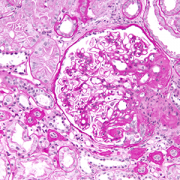Treating nephrotic-range proteinuria with tacrolimus in MTP

Mitochondria are the cell’s powerplants and inside them the MTP enzymatic complex catalyzes three steps in beta-oxidation of long-chain fatty acids.
In one family, genetic lightning struck twice. Two sisters were diagnosed with mitochondrial trifunctional protein (MTP) deficiency. This is a rare condition that stops the body from converting fats to energy, which can lead to lactic acidosis, recurrent breakdown of muscle tissue and release into the bloodstream (rhabdomyolysis), enlarged heart (cardiomyopathy) and liver failure.
Mitochondria are the cell’s powerplants and inside them the MTP enzymatic complex catalyzes three steps in beta-oxidation of long-chain fatty acids. MTP deficiency is so rare that fewer than 100 cases have been reported in the literature says Hostensia Beng, M.D., who presented an MTP case study during the American Society of Nephrology’s Kidney Week.
The 7-month-old girl with known MTP deficiency arrived at Children’s National lethargic with poor appetite. Her laboratory results showed a low corrected serum calcium level, elevated CK level and protein in the urine (proteinuria) at a nephrotic range. The infant was treated for primary hypoparathyroidism and rhabdomyolysis.
Even though the rhabdomyolysis got better, the excess protein in the girl’s urine remained at worrisome levels. A renal biopsy showed minimal change disease and foot process fusion. And electron microscopy revealed shrunken, dense mitochondria in visceral epithelial cells and endothelium.
“We gave her tacrolimus, a calcineurin inhibitor that we are well familiar with because we use it after transplants to ensure patient’s bodies don’t reject the donated organ. By eight months after treatment, the girl’s urine protein-to-creatinine (uPCR) ratio was back to normal. At 35 months, that key uPCR measure rose again when tacrolimus was discontinued. When treatment began again, uPCR was restored to normal levels one month later,” Dr. Beng says.
The girl’s older sister also shares the heterozygous deletion in the HADHB gene, which provides instructions for making MTP. That missing section of the genetic how-to guide was predicted to cause truncation and loss of long-chain-3-hydroxyacl CoA dehydrogenase function leading to MTP deficiency.
The older sister was diagnosed with nephrotic syndrome and having scar tissue in the kidney’s filtering unit (focal segmental glomerulosclerosis) when she was 18 months old. By contrast, she developed renal failure and progressed to end stage renal disease at 20 months of age.
“Renal involvement has been reported in only one patient with MTP deficiency to date, the older sister of our patient,” Dr. Beng adds.
Podocytes are specialized cells in the kidneys that provide a barrier, preventing plasma proteins from leaking into the urine. Podocytes, however, need energy to function and are rich in mitochondria.
“The proteinuria in these two sisters may be related to their mitochondrial dysfunction. Calcineurin inhibitors like tacrolimus have been reported to reduce proteinuria by stabilizing the podocyte actin cytoskeleton. Tacrolimus was an effective treatment for our patient, who has maintained normal renal function, unlike her sister,” Dr. Beng says.
American Society of Nephrology’s Kidney Week presentation
- “Treatment of nephrotic-range proteinuria with tacrolimus in mitochondrial trifunctional protein deficiency
Hostensia Beng, M.D., lead author; Asha Moudgil, M.D., medical director, transplant, and co-author; Sun-Young Ahn, M.D., MS, medical director, nephrology inpatient services, and senior author, all of Children’s National Health System.











